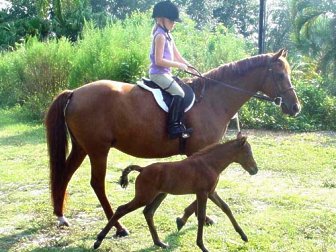
OVERVIEW
At first glance one may think they are viewing an Arabian in miniature as they carry many of the same characteristics. Despite their smaller size Caspians are a horse not a pony even though it stands at only 10-13 hands. A photo of a Caspian without a person standing beside the horse for perspective, gives the illusion of a much larger Thoroughbred or Arabian.
PHYSICAL DESCRIPTION
Due to their mountainous origin their hocks are more angled and their mane tends to grow longer than the desert-bred Arabians, and their growth rate is enormous during their first 18 months. Their feet have very strong walls and sole and very little frog, a foot that rarely requires shoeing. Caspians come in all solid colors and possess a natural action with suspension at all gaits.
Were it not for the valiant efforts of a woman named Louise Fiorouz the current status of the Capsian might read Extinct instead of Critical. It was she who in the 1960's rediscovered this ancient breed in the mountains of Iran where she began a breeding crusade over the next two decades to preserve the Caspian. Her efforts eventually paid off and a nucleus core of stock was secured and exported to the safety of Europe.
The Caspian has maintained its small, elegant stature of approximately 10-12 hands for almost 5,000 years. Research has demonstrated that the Caspian has kept its small stature under all types of demographic and environmental conditions, further evidence of its purity, distinction and unique lineage over so many centuries.
INTERESTING FACTS
In 1992 there were only 38 purebred Caspians listed in the registry book. Efforts were made to capture and identify feral Caspians to suppliment the gene pool. Even with recent importations Caspians numbers in the US are relatively low, 100 at best, 300 globally.
From research, it has been determined that the horses depicted on the walls of the ancient palace of Persepolis, did actually exist and were not mere "renderings" of an imaginery small horse.
INFLUENCES
1. 5000 year old Royal horse of Persia
For more information:
Kristull Ranch breeders
Caspian Horse Society of the Americas
Listed as "Critical" by The American Livestock Breeds Conservancy (2004)